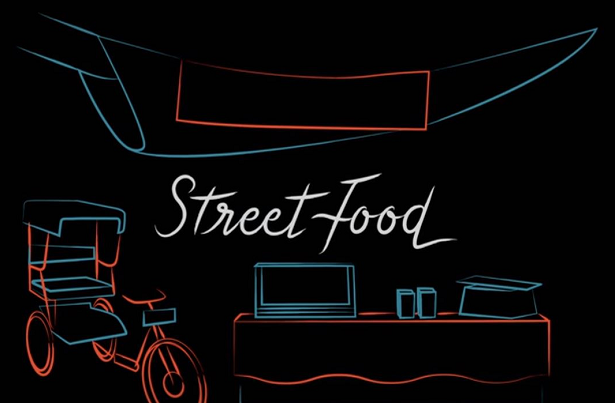Catastrophic Reviews: The Laws of Cooking

Why Hello there, and welcome once again to Jon’s Murder Madhouse, where your souls…I’m sorry, this is the wrong cue card. That’s for this weekend. My bad. No, today is a CATASTROPHIC REVIEW, where we take a look at a facet of food culture (a show, a cookbook, a food-themed manga if I ever get my Christmas present from Joe, HINT HINT.) and discuss its pros and cons.
Last week, I talked about failing to roast chestnuts for a Vegan Philly Cheesesteak. I’d say many of you were interested in it, but that would be a lie, as the great masses of my readers are an inscrutable and impassive lot, like Easter Island Heads with Facebook accounts.
Who, fun fact, actually had BODIES under their heads! Turns out everyone in the 1800's just looked at the big stone heads and said 'yeah, that's probably all there is to those."
Against the eternal deafening silence, I decided to talk more about the cookbook in question, because I think it has some fun ideas and quirks, and also because I hadn’t written a review in a while. Of course, IMMEDIATELY after I made that decision, a new food show launched on Netflix, so I’ll probably review THAT in a week or two. But for now, let’s talk about Justin Warner, and his book, “The Laws of Cooking (And How To Break Them.)”
This Justin, New York Attacked without Warner
Justin Warner, as I briefly covered some time ago, is something of a fascinating character in the periphery of the modern food scene, specifically Food Network. A waiter by trade, Justin kind of stumbled onto a TV show audition because of a woman he was with at the time, and ended up not only appearing on a Food Network competition show, he won it! The show was a relatively short-lived program named 24-Hour Restaurant Battle, and Justin’s victory, in his own words, was unexpected.
Shortly after, he and his friends opened a restaurant, and Justin ended up on another Food Network show: The Next Food Network Star. Justin competed for all of season eight, reaching the finale where he (spoilers) won! …And proceeded to not become a Food Network Star. Just as his victory in Restaurant Battle didn’t actually get him a restaurant, his victory here didn’t get him a show. Justin had a pitch for a show, but for some reason, it didn’t pan out. A single hour-long pilot of a show derived from that pitch aired…and produced no great response. It’s like he’s been cursed by a vindictive witch he beat in a track-and-field event, so that he will do nothing but succeed, but his reward shall always be disappointment.
In Justin's defense, the witch clearly had no hope of winning, so why did they even enter?
Presumably he either hired an exorcist or made amends, because Justin started making a stronger television showing starting in 2014, where he would often appear on other star’s shows, either as a judge, a guest cook, or sometimes as a contestant. In an amazing coincidence, as I took a break from writing this summary of him to cook dinner, I ended up watching him compete on Guy’s Grocery Games, in a celebrity-chef-studded season that aired just last year. He made it to the finale of that season as well, where he…may or may not have won, I don’t know. I was watching it to kill time while eating dinner, and left partway into the episode. Look, I had things to do. Mostly writing this. And watching Youtube videos. Alright, mostly watching Youtube videos AND writing this.
“Ugh, fine, Jon,” You say, in that frustrated tone you use when you think my asides aren’t particularly interesting, and that honestly hurts my feelings when you use it, “What does any of this have to do with the COOKBOOK?” Glad you asked!
What Any of This Has to Do with the Cookbook
As you may recall, I grade cookbooks on a set of four criteria, literally only one of which is even vaguely about the actual recipes involved: First, I ask, does it look and feel nice (Production Quality)? Second, how interested and excited does it make me to try the recipes in it (“Catapult” effect)? Thirdly, does the author’s word choice, anecdotes, and the tone of the book please me (Voice)? And lastly, is the book “coherent to itself”: like, does this book that claim to be for the everyman keep asking for expensive or hard-to-find ingredients? Does the voice vary wildly across the book? Does the book answer the fundamental question of the piece? I call this last step “unity of theme.”
And those criteria are all perfectly fine, but I’ve recently realized just HOW important/varied Voice can be: there are many cookbooks that strive for neutrality, that present their recipes as perfect, platonic ideals. And, more and more, we’re seeing cookbooks that are imbued with an author’s voice, because the POINT is at least somewhat to ‘share the experience ‘of the cookbook with the author.
This is part of the appeal of Eat Me, which I recommended last September: Kenny Shopsin is a weird guy, who has done weird things, and met weird people, and is a funny, weird, kind-of-a-dick old dude. Understanding Kenny is a key part of understanding why he makes food the way he does.
In a word, 'Thickly',
Therefore, it’s important to remember that I said Justin is a WAITER by initial trade: he has no formal culinary teaching. He just kept hanging out with cooks and chefs, saw what they did, and did it himself. He’s regarded by other chefs as a sort of “Weird Science” kind of chef, because he uses weird chemicals and off-beat choices. Justin frequently says, in his TV show appearances, and in his cookbook, that he’s always trying to break the rules and get away with it, everywhere he goes. So let’s talk about how he makes rules just to break them!
Voice
AS with many modern cookbooks, each recipe is preceded by a quick introduction by Justin, discussing his history with the dish, why he makes it, what he thinks about it, and so forth. Each CHAPTER starts the same way, as Justin has to explain to you the “Law” he’s discussing. And since it’s in the title, and we’re talking about it, let’s discuss what exactly Justin’s Laws of Cooking are: In essence, they’re an enumeration of specific iterations of a culinary Kuleshov effect; a sentence I wrote so I can win Stuck-Up Asshole Bingo. To understand it, the important part is the Kuleshov effect, which is a film term for the fact that viewers derive more meaning from two shots together than one in isolation. A man in a tuxedo weeping is a picture. A man in a tuxedo weeping, and a woman in a wedding dress lying in front of a car is a tragic story. If that car is the Oscar Meyer Wienermobile, then we’re probably in a Coen Brothers film.
And we could reasonably make any of these faces in the seconds before the Wienermobile hit us.
So, Justin made a series of “laws” that are, in essence “pairing flavor X with other flavor Y creates a good dish.” Boom. That’s the foundation. So, for instance, the Law of Peanut Butter and Jelly: rich fat with acidic fruit. Peanut butter and jelly is of course the standard bearer, but if you remember that tomatoes are an acidic fruit, then you see that Tomato soup and Grilled Cheese also fits. Or, to take things too far as Justin so loves, a Foie Gras & Jelly Doughnut.
And here’s a fun part of this cookbook’s charm: Justin’s voice is not simply in the text. It’s in the recipes, the ingredients, and the methods. He suggests you try making a sous vide turkey breast for turkey paprikash, and tells you how to make a ghetto sous vide machine out of hot water and an ice chest. He cold smokes salmon with a mattress pump, because smoking machines are expensive. He decks out $30 a pound fish with pepperoni slices. He’s the Mad scientist of the cooking world.
This is presumably some kind of Doomsday device.
Production Quality
There are pictures and colors everywhere in this book, a choice that keeps the lively, experimental feel of the text going. There’s drawings of Justin’s slapdash smoker, illustrations of the scientific processes he’s alluding to, and more. The book is weighty, but not oppressively heavy. For the first few months of owning it, I felt that the corners of the hardcover were unnecessarily sharp, but months of grating personality have worn them down over time. It’s well-made enough to be impressive, but not so well made that I fear bringing it in the kitchen.
“Catapult” Effect
This is, tragically, the biggest loser of the categories. I had this book for a YEAR before I seriously attempted to make anything from it, an act I immediately failed at miserably. In the book’s defense, that’s at least somewhat in part due to my living situation. As I have repeated ad nauseam, my father was not an adventurous eater at the height of his culinary explorations, and he is even less of one now. Do I like the sound of a dark chocolate cake with habanero and bourbon in it? Fuck yeah. Will I convince ANYONE in my house to eat it other than me? Unlikely.
I will argue, however, that the book has a…I guess “side effect”. I may not make recipes from it, but reading through it, I was definitely inspired to be more adventurous. To push boundaries, and mix things that might not seem to go together more often when eating. It doesn’t always pay off, but it taps into the same emotional well I’m trying to draw forth from you guys: the idea of pushing, and trying.
He also has a way of introducing weird things in ways that make them less scary: “agar agar” is a gellification agent that you may have never heard of. But when he uses it to make fake tomatoes out of V8 for a burger, it FEELS more normal. Justin’s book may not have catapulted many specific recipes, but he’s been hurling ideas and ingredients at me all year. You think I would have had the spirit to buy citric acid without a little bibliophilic backbone?
"Blue Cheese and Hot Sauce go together...Sweet things and spicy things go together...Why not make a sweet Blue-Cheese Cheesecake, and top it with sweet hot sauce caramel?"
Unity of Theme
I noted this earlier in the Production Quality section, and it remains true: there’s a broad sense of exploration and experimentation in the text. After each recipe makes to illustrate the relevant “law”, he has a small box talking about how to “break it”, adding a third or fourth component to create even more complex interplay. He suggests how to plate the dishes in a more restaurant-quality manner, and notes in a recipe where you can stop and hold a dish, prepping in the morning and finishing for dinner, or so forth.
Break it! Plate it! Bop it! Pass it!
Do do do doo do.
That sense of unrestrained culinary creativity bounces around the book like a puppy on coke, crashing into this recipe and that one, knocking things over and upsetting simplicity.
Final Verdict
Personally, I deeply enjoy the book. But I can easily see how it’s not for everyone. It’s perhaps a little too avant-garde for the unexperienced cook or the timid palate. Kiwi Oysters Rockefeller is a statement dish, and that statement may not work for everyone. I would recommend, if possible, taking a minute or two to peruse the pages before you buy. I think it’s sufficiently self-infused that you’ll pretty quickly know if you like it or not. I’d recommend all my readers check it out, but I get it if they don’t buy it.
Thanks for tuning in for our review of this cookbook! If you have cookbooks, shows, or other documents that you’d like Jon to take a look at, consider supporting us on Patreon, where you can help decide what the blog covers. Or, if you wish to leave your fate solely to Jon’s fickle whims, just message us your suggestion on Facebook! Jon will definitely see it, and think about it. Now, let’s learn what the Patrons have picked for next Monday’s dish.
MONDAY: THE VOTES ARE IN, AND IT’S…A TIE?! GODDAMN IT. ALRIGHT, YOU KNOW WHAT, THEY’RE BOTH DOUGH BASED, SO WE’RE DOING SOFT PRETZELS AND STROMBOLI, TWO PHILLY TREATS FOR SUPER BOWL EATS.
THURSDAY: UGH. I HATE DOING IT SO SOON AFTER, BUT I ALSO LIKE TO FEEL AT LEAST KIND OF RELEVANT, SO I’LL REVIEW THE NEW NETFLIX FOOD SHOW: “SOMEBODY FEED PHIL.”












